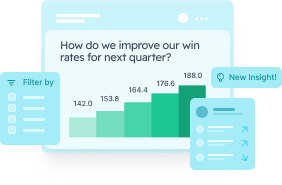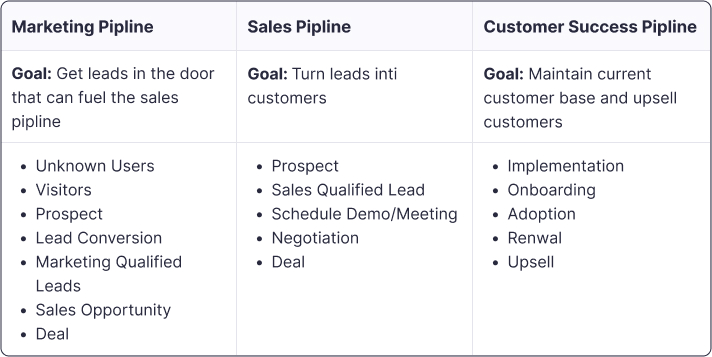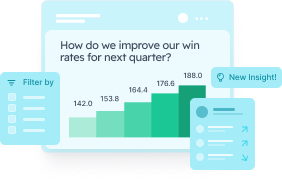Sales Pipeline Management: A Guide for RevOps Teams

Co-Founder & CEO
The most effective sales, marketing, and customer success teams have Revenue Operations (or RevOps) partners behind the scenes who are managing pipeline, monitoring cash flow, and helping set revenue goals.
While pipeline management is just one component of the RevOps team’s responsibilities, it should be a top priority. Not only does optimizing pipeline help bring teams together through shared goals, it can significantly impact a company’s revenue. A study by Harvard Business Review found that companies with effective pipeline management had an average growth rate of 5.3, a 15% increase over companies that reported having ineffective pipeline processes.
Learn everything you need to know about pipeline management, from sales pipeline examples to pipeline analytics, to help you increase revenue for your company.

What is pipeline management?
While the exact definition of pipeline management differs between companies and departments, in general it is the process of tracking a company’s cash flow from the moment a potential customer shows interest in your services to the time they sign up for your services. This is often visualized as a vertical diagram that displays different stages and tracks a potential customer’s movement through the sales process.
Sales pipeline vs. sales funnel
Sales pipeline and sales funnels have a lot in common because they showcase two sides of the same story. While a sales funnel looks at the customer journey through the customer’s eyes, the sales pipeline evaluates the customer’s journey through the business’ perspective. For example, in terms of a sales funnel, a customer may have awareness of your brand and show interest in your services. Within the sales pipeline, this could translate to the prospecting and qualification stages.
Meet our new Metrics Library!

Pipeline Examples
Pipeline tracking can look very different across SaaS companies and across teams depending on the nature of the services. For example, a SaaS company that offers a subscription service will have a different set of qualifications compared to one that offers a pay-as-you-go model or a one-time payment model. Keep this in mind as you build and adjust the pipeline at your company.
Here’s an example of what a pipeline management system could look like across marketing, sales, and customer success departments. 
Start managing pipeline with ease.
Why is pipeline management important?
Pipeline management enables many teams throughout the company, such as RevOps, sales, marketing, and finance teams to improve processes and more accurately set goals. Take a look at the following benefits of optimizing your pipeline:
Accurately forecast: Managing pipeline helps businesses understand if they’re on track to meet their goals, and better enables teams to accurately estimate revenue for the year.
Reach goals: Not only are teams better able to estimate revenue, they’re also better able to track toward their goals by understanding and addressing the stages of the pipeline that aren’t performing as well.
Increase revenue: By having resources dedicated to pipeline optimization, improving sales processes and moving leads from stage to stage, companies see an increase in overall revenue. As mentioned above, companies with effective pipeline management had an average growth rate of 5.3, a 15% increase over companies with ineffective pipeline processes.
Improve customer relationships: Pipeline optimization can have a positive impact on your customers. By pinpointing the areas of the pipeline that are slow, teams can enhance the customer experience by optimizing those portions of the sales cycle. This ensures that customers don’t drop off due to a slow response time.
Start managing pipeline with ease.
How pipeline management facilitates business processes
Pipeline management streamlines and improves many aspects of a business by finding gaps in current processes, setting more accurate goals, and removing silos between teams.
Identify areas of improvement
By keeping an eye on each stage of the pipeline, you can more easily identify the gaps, where teams are running into issues, and where there needs to be additional support.
For example, if only 10% of marketing qualified leads (MQLs) are turning into sales qualified leads (SQLs), it’s possible that the users are becoming MQLs too soon and need to meet additional criteria in order to make it to that step. As a RevOps team member, you can then adjust that criteria to ensure higher quality MQLs are making it through to the next stage.
Avoid lead leakage
Without pipeline management, leads can fall through the cracks and get lost in the day-to-day hubbub. By monitoring pipeline and how much time leads spend within each stage, RevOps teams can help sales reps shepherd leads through the sales process, avoiding unnecessary drop off and a negative experience with the company.
Define a sales process
Companies that define a sales process can see dividends. In fact, Harvard Business Review found that there was an 18% difference in revenue growth between companies with a well-defined sales process and those without. By developing a pipeline system, you can organize your sales process, make improvements to the stages, and more accurately pinpoint what isn’t working.
Set more accurate goals
Pipeline management allows teams to set more accurate goals across each stage, which then influences the overall revenue trajectory for the company. By having a deep understanding of each stage of the pipeline, RevOps teams understand when to dial up or dial down certain stages in order to reach the company’s revenue targets.
Remove silos from teams and data
When you manage pipeline, you help align sales, marketing, and customer success teams, keeping them on track toward shared goals. These teams need to be working hand-in-hand to find, deliver, and close high-priority leads as well as build the best possible customer experience.
In addition to team collaboration, bringing in data from all three teams is vital to having a comprehensive picture of the revenue being created for the business. Because each team feeds into the other, bringing the data together, allows RevOps and Finance teams to better forecast for the year, set goals for each team and each stage, and keep a pulse on the overall health of the pipeline.
For more best practices on aligning sales and marketing teams, check out our article, B2B sales and marketing alignment: Best practices for long-term growth.
Start managing pipeline with ease.
Pipeline management best practices: Lean on your data
As you streamline pipeline processes at your company, know that data will be your biggest asset.
Know your metrics
When monitoring pipeline, metrics are your best friend. From SQLs to sales cycle length, metrics will let you know if you’re in the green and charging in the right direction or if you need to make adjustments to the pipeline. Here are a few metrics to prioritize for pipeline management in sales:
Revenue analytics platforms like Sightfull make it easy for RevOps teams to keep track of metrics across each stage of the pipeline. You can drill down on leads and renewals, use out-of-the-box dashboards, or easily configure your own reports. Sightfull also provides hundreds of pre-calculated SaaS metrics based on industry standards and best practices so that your metrics are automatically calculated according to industry benchmarks.
Share data across revenue-driving teams
Give everyone access to the same data. If all teams, RevOps, marketing, sales, customer success, and executives are all speaking the same language and keeping tabs on the same numbers, this will increase collaboration and streamline decision-making across the company.
Designed for business users, Sightfull can be used without asking your data analyst teammates for assistance. Offering a 360° view of business performance, from sales leads to renewals and retention, members across your organization can quickly get the answers to their team’s pressing questions.
Understand where leads are coming from
Another advantage of bringing together data across GTM teams is that RevOps teams have more insight into where leads are coming from. Whether it’s events, webinars, reports, or cold outreach, lead pipeline management can help teams understand what levers need to be pulled when and where to increase leads.
By tracking the sources, the number of leads being qualified over time, and the time it takes to be converted from an MQL into an SQL, RevOps teams can give marketing and sales teams the information they need to boost lead generation and create new pipeline.

Focus on high-value leads
Focusing on high-value leads can be challenging if there’s no system in place to identify what is a high-value lead. Try implementing lead scoring to help you measure each lead that comes through your door. Lead scoring allows you to assign points to leads and prospects according to specific criteria.
For example, if a lead attends a webinar, assign them 50 points. If they download a guide, assign them 25 points. Once they reach the 100 point threshold, you could consider them an MQL. You’ll need to understand what channels are the best drivers of high-quality leads in order to assign the appropriate amount of points to each activity. Work hand-in-hand with your marketing and sales partners to make sure you’re getting the full picture.
Keep your data clean
If your data isn’t clean, there is a domino effect of poor decision making based on unreliable information. Regularly cleaning your database is vital to ensuring a healthy and reliable pipeline.
Luckily, data hygiene doesn’t have to be a time-consuming process. You can eliminate all manual data hygiene work with Sightfull. After Sightfull collects the data, it uses logic models to audit, validate, and reconcile the data. Alerts are provided in real-time to highlight data inconsistencies that need attention in order to build accurate reports.
Address roadblocks early
Your pipeline will never be perfect, and that’s okay. It’s a constant process of adjusting and improving. Keep an eye out for trends, hiccups within the process, and areas to improve. Catch and address these blips early to avoid inaccurate reporting and forecasting.
Whenever anomalies, variances and correlations are detected inside your data, Sightfull sends proactive alerts to make sure you never miss any revenue trends, positive or negative. This gives you the ability to identify roadblocks early and course correct your pipeline or Go-to-Market strategy before it’s too late.
Consider a revenue analytics platform
To help you manage pipeline, monitor all relevant data points, and keep track of how leads are moving from stage to stage, it’s worthwhile to consider a revenue analytics platform such as Sightfull. Sightfull integrates with Customer Relationship Management systems (CRMs) and Business Intelligence (BI) tools to provide a holistic view of your company’s data as well as help you drill deep into the details.
Sightfull’s Marketplace offers pre-built templates that include common KPIs and metrics for GTM teams. By selecting a template or a metric and connecting your data to Sightfull, you can access helpful insights in seconds.
Check out a few of the pipeline templates that Sightfull offers:
Start managing pipeline with ease.
Unlock revenue with pipeline management and analytics
By managing pipeline, RevOps teams get a deeper understanding of what’s effectively driving business forward. This makes it easier to pivot if something isn’t working and helps you identify the tactics that are bringing in new, high-quality leads that close deals.
Takeaways for successful pipeline management
As you develop a pipeline management process and discover what works best for your company, use the best practices in this article to help guide you. Remember:
- Keep your data clean across GTM teams—you’ll save yourself headaches down the road!
- Lean on data to tell the story of your sales pipeline and help you identify areas of improvement
- Understand lead sources and put together point scoring systems to identify high-value leads
- Use a revenue analytics platform to help you more easily manage pipeline
Having the right platform to help you make data-backed decisions is essential. Sightfull empowers GTM teams to take ownership of their metrics and reports without the need for coding skills.
Talk to an expert
Learn about sales pipeline management, what it is & why it matters
Sales Forecasting Accuracy
Use our Pipeline Waterfall Template to optimize your pipeline management with ease

















